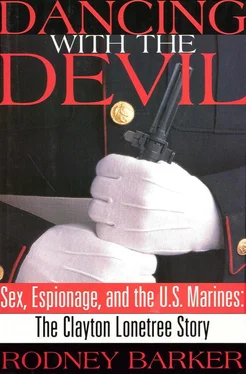Because the investigation of the affair had been entrusted to the Naval Investigative Service, the consensus was that the NIS had badly bungled the case. Even before the charges against Arnold Bracy were dropped, the press had changed from a mode of reporting the event to critical scrutiny of the investigation. Under such banner headlines as “Marine Scandal Puts Probers Under Cloud,” it had been written that the NIS had made an important decision early on to focus on damage assessment, and in its rush to determine the extent of the spying it had failed to adequately collect physical evidence for prosecution. After Bracy, the question on everyone’s mind was summarized in a Time magazine article: “There was sufficient detail… to see a classic espionage pattern, but did the accused embassy guards sketch that pattern, or was it provided by aggressive, overzealous agents of the NIS?”
The search for an answer was initiated by Reps. Daniel Mica and Olympia Snowe, who requested a formal inquiry into the NIS investigation by the General Accounting Office, the official Congressional investigative agency. But to the dismay of those hoping to pin excesses and exaggerations of the Marine Spy Scandal on the NIS, the GAO report concluded that while the Bracy confession remained an unexplained hole at its center, the Naval Investigative Service had conducted a “logical, thorough, and professional” inquiry.
Despite the exoneration, disappointment ran deep at the NIS. When Lonetree cleared the polygraph, Lanny McCullah, who had worked tirelessly for months on the case and had been absolutely convinced that Lonetree would confirm at least a portion of Bracy’s statement, was so devastated he didn’t show up for work for three days. When he resumed his duties as director of Bobsled, McCullah put on a philosophical face, maintaining that just because the NIS effort had not resulted in more people being convicted or brought to trial, that didn’t denigrate the performance of the Bobsled task force.
“Should we have looked for wider recruitment and deeper penetration?” he would say. “We’d have been remiss not to. Should we be criticized because we didn’t find anything? That’s not fair. Maybe it seemed we spun this all up, but how do you look at that without spinning it up?”
In this regard he felt the blame for what went wrong ought to be shared by the Congressional committees who had been insatiable in their demand for briefings and updates, and had taken NIS’s investigative leads and prematurely released them as facts; the impacted organizations who had taken NIS’s raw intelligence data and, if it made them look bad, used it for damage-control instead of damage-assessment purposes; and the press, who had relied on unverifiable leaks from anonymous sources with political agendas and hyped the worst-case scenarios, creating public expectations that were greater than what NIS could ultimately prove.
This had been one of those frustrating investigations where something looked red today and then two months later another piece of information would come along and suddenly what you had was a different color. As it turned out, it was also a case in which outside circumstances functioned like a light source that projected a larger and more ominous shadow than the actual object. But espionage was a world in which shadows often had substance, and Lanny McCullah was convinced that any reasonable person, having access to the same information he had, would have made the same decisions. He had not concocted the idea that a KGB worldwide MSG recruitment campaign was going on—that notion had come from a Soviet defector. He had not come up with the theory that the American Embassy had been penetrated—no one was even thinking like that until Arnold Bracy raised their suspicions.
Throughout the investigation McCullah had talked confidently about an inevitable “big break” he knew would come with the next witness interview or the discovery of a planted eavesdropping device. But the closest he’d come to something like that turned out, in the end, to demonstrate the impossible situation NIS had found itself in.
By early June, notwithstanding press reports of an embassy riddled with Soviet “bugs,” he had yet to receive official notification of the results of technical sweeps of the embassy and the inspection of dismantled embassy communications equipment. Given the difficulty he’d encountered obtaining any information from the CIA or State Department that might prove embarrassing to either agency, he reasoned that if a planted device was found, that information might not be released to NIS, because to do so, while providing the needed corroborating evidence, would invite additional outside scrutiny and significant embarrassment to both agencies.
While discussing the dilemma with his deputy Bud Aldridge, McCullah hit on another strategy. They could sit back and wait for a report that might never arrive, or they could become proactive and maybe by pushing the right buttons generate sufficient pressure to force a candid and truthful response. It was decided that McCullah would arrange a meeting at FBI headquarters with their director of counterintelligence, Buck Revell, and the CIA director of counterintelligence, Gus Hathaway, to discuss Bobsled and Moscow, leaving the specific agenda intentionally unspecific.
At that meeting, after presenting the group with a status report, McCullah surprised everyone with an exfiltration proposal. He named three candidates—Galya, Violetta, and Uncle Sasha—and suggested the CIA contact them and offer them a million dollars to defect from the Soviet Union and testify in the United States, after which they would be placed in the FBI’s defector program.
McCullah realized the proposal was a wild shot that the CIA would probably turn down because its exfiltration procedures and routes for defectors were closely guarded and reserved for the most critical situations. He suggested it anyway to project his displeasure at what he perceived to be a lack of assistance from both the FBI and the CIA, and to put them on the defensive before he moved on to the main issue: the lack of information being provided regarding the technical inspection of the embassy and its communications equipment. Not one word had been received by NIS in that regard, he said in a voice that made no effort to conceal his annoyance, yet the media was reporting unnamed FBI and other government sources of having knowledge of bugs. If it was true, if there was evidence the embassy had been penetrated, he wanted to know before Lonetree’s court-martial.
The discussion obviously got the FBI’s attention, because they advised they would take the lead and make an inquiry into the matter. Several days later a package arrived at Bobsled headquarters that contained an explanatory letter and a photograph of the code machine used by the State Department and the CIA in Moscow to take messages and scramble them into electronic signals that could only be deciphered in Washington and Langley. Attached to the cable leading into the machine was an anomaly that had been discovered by technical personnel. No one knew what it was, but it didn’t belong there. There were safeguards built into this particular piece of equipment that supposedly made it tamperproof, and if it had been tampered with—if, for instance, a repair had been done—there should be an audit trail. But there were no records to indicate any work had been done on it. Its location suggested that it might be a device to decode encrypted electronic messages and that it may have been installed by Soviet technicians.
McCullah and Aldridge were less than thrilled. An anomaly was exactly that: something that could not be explained. It might be significant, it might not. Had technicians from the KGB’S Technical Support Group penetrated the embassy’s most sensitive and guarded inner sanctum long enough to make or install a subverting modification? Or had an overworked embassy technician simply made a repair and in haste forgotten to make an annotation in the equipment log? Was it the elusive “smoking gun,” or just another lapse in security procedures?
Читать дальше












